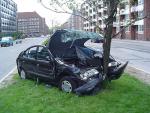New regulations from Brussels for periodical technical inspection (PTI) of automobiles will cost Slovakia’s drivers some 30 million euro, with questionable benefits says Radovan Durana, IREF correspondent in Slovakia (INESS).
The major change in the new EU directive is the obligation to take your car to inspection every year if it is older than 6 years. While the objective is laudable – reducing the number of fatal accidents by taking faulty vehicles off the roads – establishing the direct correlation between new technical standards and improved statistics is far from easy. There are arguably great differences in average technical advancement of automobiles in Sweden or Bulgaria, reflecting the budget of consumers to be spent on mobility.
Meanwhile, the number of road casualties in the EU has decreased significantly; and in Slovakia the number of accidents targeted by the new regulations was also reduced (there have been no reported fatal injuries over the past 6 years!).
Other factors must be included. As underlined by the paper: “Accident severity increases naturally with age” regardless of the technical state of the car. The average age of a vehicle in Slovakia is 11 years, and the new regulations will affect 1.2 million vehicles (out of a total of 1.8 million). This amounts to an additional 600,000 inspections every year with a cost of 24 million euros, and a loss in time for drivers representing some 7 million euros, in total 31 million – “a decent transfer of wealth from the vehicle owners to the managers of technical inspection bodies”.
What about effectiveness? According to the directive, the costs incurred should yield a 60 per cent decrease in mortality due to technical failures, which in turn account for 6 per cent of fatal road accidents in the EU. In the case of Slovakia, the new regulation would save 12 lives. (Compare this to the fact that animals caused 723 accidents in 2010 alone.)
Yet there are many other ways of improving road safety (safer intersections, speed limits in urban areas etc). A reasonable and market-based alternative would be to link voluntary inspections to the level of car insurance premiums (again assuming a strong correlation between the two).
Further, “harmonisation of rules which directly or indirectly creates additional cost of a car fleet, will de facto impoverish the population of the less developed countries as it increases the cost of mobility.”
INESS Policy Note (July 2012)
By M. Vlachynsky and R. Durana
English translation by J. Betinsky



